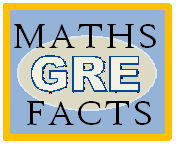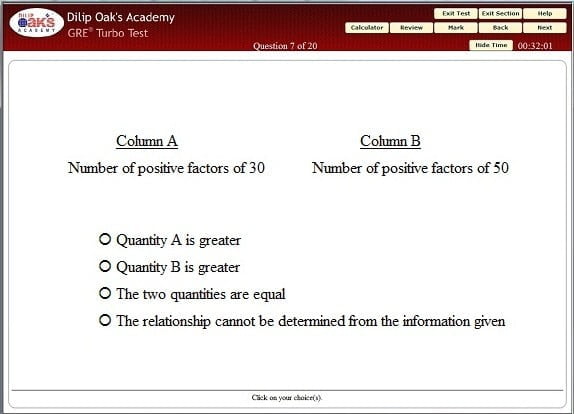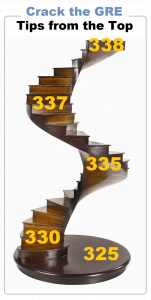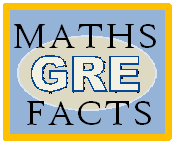- Tips from Adheesh Gokhale (GRE Score: 338/340) – working student: Admitted to State University of New York, Stony Brook (fall 2013), Master’s in Computer Science
- Tips from Ashwin Ranna (GRE Score: 337/340): Admitted to Carnegie Mellon (fall 2013), PhD in Environmental Engineering
- Tips from Tanmay Gurjar (GRE Score: 335/340): Admitted to University of Texas, Austin (fall 2013), Master’s in Mechanical Engineering
- Tips from Debanjana Nayak (GRE Score: 330/340) – working student
- Tips from Rasika Joshi (GRE Score: 325/340): Admitted to Wisconsin Madison (fall 2012), MS-PhD (Electrical Engineering)
cracking the gre
Quantitative Comparison Questions: Doubtful D!
Now, here’s a tip about the weird GRE question type called Quantitative Comparison or simply QC. As we know, in QC questions there are two columns, ‘A’ and ‘B’, containing some quantities. Our job is to evaluate the quantities and compare their magnitudes. In QC questions, the options are always as follows:
(A) Quantity under Column A is GREATER THAN quantity under Column B
(B) Quantity under Column A is LESS THAN quantity under Column B
(C) Quantity under Column A is EQUAL TO quantity under Column B
(D) RELATIONSHIP CANNOT BE ESTABLISHED using the given information.
Now look at this example:
x2 – 2x – 24 = 0
y2 – 3y + 2 = 0
Column A Column B
x y
The question asks us to compare ‘x’ and ‘y’. In order to get the answer, we need to solve both the quadratic equations. When we do this, we get the following values: x (4, -6) and y (2, 1)
Thus, if we pick 4 as the value of ‘x’, it is greater than both values of ‘y’. Hence, option (B) and option (C) can be rejected outright.
Now, we are left with only two options, (A) and (D). But if we pick -6 as the value of ‘x’, it is less than both the values of ‘y’ so, we have to eliminate option (A) and thus, we have option (D) as the final answer!
Why was this example given? To show you that is that the only time we need to be extra cautious when solving QC questions is when we think that the answer is probably option D!
Now, try this one:
X < (1/X)
Column A Column B
X X2
see answer here
Did You Know these Facts about GRE Math?
~ By our Quantitative Reasoning Faculty

April is almost over and the countdown to the exam has already begun. You want a good overall score and if you’re an engineer, you are most probably thinking that getting 165 on Quant shouldn’t be too much of a problem (the typical engineer approaches maths questions with a raw “Just bring ‘em on” kind of arrogance and usually gets most questions right). But here’s the problem: sometimes even those with a strong background in maths may not cross the 160 mark – and when that happens, dreams of a score in the 325+ range come crashing down. To prevent that unhappy outcome, here are some basic insights about the way the math works on GRE.
One fundamental reason why some students don’t get the scores they should, is that they simply don’t understand the way the exam ‘TALKS’ maths. What this means is that the GRE test has its own way of defining mathematical terms. If you don’t understand the definitions used in the GRE exam, then time and time again you are going to end up making errors on questions you should have got right – and you are likely to end up feeling frustrated and demoralized. So, let’s have a look at a few basic differences between Indian maths and American math.
Answers to Practice GRE Test Quant Questions
Post: Did You Know these Facts about GRE Math?
Question: How many positive integers, less than 20, are either an even multiple of 2 or, a multiple of 9 or, the sum of a positive multiple of 2 and a positive multiple of 9?
Answer: There are 11 such integers:
- Multiples of 2 – 4, 8, 12, 16 (total 4)
- Multiples of 9 – 9, 18 (total 2)
- Sums of a positive multiple of 2 and a positive multiple of 9 – 11, 13, 15, 17, 19 (total 5)
Post: Quantitative Comparison Questions: Doubtful D!
Question:
X < (1/X)
Column A Column B
X X2
Answer:: (D)
The given inequality is X< (1/X).
This is possible only in two cases:
(1) If 0 < X < 1 OR
(2) X < -2
Now, you need to compare ‘X’ with ‘X2’
If you pick the value of ‘X’ from 1st range, let’s say ‘X’ = ½, then X > X2, thus the possible answer is option (A) and hence, options (B) and (C) can be eliminated.
But if you pick up the value of ‘X’ from the second range of values, lets say X = -3, then X < X2.
That means we are not able to reach to any unique conclusion using the information given, thus the answer is option (D)
An Easy Way to Learn GRE Words (Through Roots) Part 2
 If you found the last post on roots helpful, here are 2 more roots which cover 25 GRE words. For those of you who have come directly to this post, here’s a link that will help you understand why we are talking about roots so much: go to first roots post. (But basically, it helps to make learning the GRE words much easier).
If you found the last post on roots helpful, here are 2 more roots which cover 25 GRE words. For those of you who have come directly to this post, here’s a link that will help you understand why we are talking about roots so much: go to first roots post. (But basically, it helps to make learning the GRE words much easier).
genus generis (14 words)
The Latin word genus (cognate with Greek ‘genos’ and the Sanskrit root ‘jan’) has produced a number of English words. Genus has two basic forms: ‘genus’ and ‘generis’ (the second of which is more important because most derived words in English and other modern European languages have come from it whereas ‘genus’ exists as a single English word).
GRE Prep for Oak’s Students – Vocabulary Learning and Revision
Vocabulary Learning and Revision (to be started preferably 3-5 months in advance)

The largest, most time-consuming component of your GRE preparation is vocabulary revision. Achieving a good level of basic preparation involves getting familiar with around 4,000 words commonly used on GRE test. To really understand a word you need to know its range of meanings, some of its important secondary meanings, its usage (illustrated by sample sentences using the word) and it is often useful to know the roots of the word. Dilip Oak’s Academy has provided two very useful aids for learning and revising these various aspects. Described below is how you can use them both at home and outside.
At Home:
When at home use VaiVocabulary. VaiVocabulary is one of the best vocabulary learning softwares available in the market. It has a number of features which help to make vocabulary learning really effective. Here are some tips on how to get the most of it:
- Try out all the features in order to select which combination works best for you – some of the more important features are given below:
- Pictures – these are connected to the meaning and help to remind you of the meaning.
- Sample sentences or usage – remember you don’t understand the meaning when you learn the definition: real understanding comes when you see how the word is used in sample sentences.
- ‘Video’ – most of this is really audio, but the videos give really good explanations of word meaning and lots of additional sample sentences.
- Mnemonics – ways of linking the meaning of the word with the form of the word; many are given; select the ones you find most useful.
- Word origins – these are the roots of words which help you to understand the meanings of words rather than just learning them by heart.
- Synonyms – the easy synonyms help you to understand the meaning of a word better; the hard ones extend your vocabulary.
- Mark any word you cannot remember ‘very difficult’ by default so that you will be able to repeatedly revise it; lower the rating when you get better at remembering.
- most important: sincerely go through all quizzes, the rapid revision (it comes up at the beginning of a new session) and the difficulty-based revision sessions.
- The VaiVocabulary DVD has a tutorial that will take you through all the available features and explain how to use them
- If you run into any problems with installing or using the DVD contact the Academy – all the problems can be fixed one way or another, but don’t let problems prevent you from the enormous benefits of using this great vocabulary learning software.
Outside (i.e. when you are not at home): Use FlashCards and FlashCard Companion
- The FlashCards contain 4,000 GRE words and their meaning; 2-3 shades of meaning are given for every word.
- The FlashCard Companions are booklets which give you a sample phrase for every meaning of every word in the FlashCards.
- Every page in the FlashCard Companion booklet corresponds to a FlashCard. The number of the FlashCard is given at the top of the page. Word numbers are also given for ease of reference.
GRE Prep – Preliminary Reading
 One of the most important aspects of preparing for reading comprehension in the GRE is preliminary reading – that is, reading to be done before you start tackling GRE RC passages in order to prepare you for the challenges that those passages will throw up.
One of the most important aspects of preparing for reading comprehension in the GRE is preliminary reading – that is, reading to be done before you start tackling GRE RC passages in order to prepare you for the challenges that those passages will throw up.
One challenge that you will face on Reading Comprehension passages is that they tend to be about unfamiliar topics and concepts; and talk about unfamiliar terms and fields. They use difficult phrasing and vocabulary, and complicated sentence structure. The only way to get used to the level of complexity you will find in GRE passages is to read widely.
Another challenge is the fact that reading passages on screen means that you may not be able to see the whole passage at a time, and may have to scroll up and down to read the rest of the passage. This is very different from reading on paper, where you can usually see the whole passage on screen at a glance. The fact that, when reading longer passages onscreen, you will not be able to see the whole of the passage at once makes comprehending the passage much more difficult.
Reading widely both on paper and onscreen will help you build up the skills that you need to meet the challenges presented by reading comprehension passages in the GRE. The reading material suggested here is arranged, and should be read, in the following order:
Cracking the GRE Test – Debanjana Nayak (GRE Score 330/340) – Tips for Quantitative,Verbal and Analytical Writing
Here’s the next part of Debanjana’s tips – this time with lots of specifics for each section of the test!
______________________
Before starting with this set of tips specifically for the Quantitative, Verbal and AW sections, I must mention that I took classes from Dilip Oak’s Academy and I will be talking a lot about the Academy’s classes and materials because I found them extremely useful in preparing for these sections. In giving these tips, I am also assuming that you too are a student of Dilip Oak’s Academy. Of course, you will have your own experience and perspective, but here’s what I would suggest.
Cracking the GRE Test – a Working Student’s Experience – Debanjana Nayak (GRE Score 330/340)
This week’s blog is by another of our high scorers, Debanjana Nayak who got a a really great score of 330/340. What makes this score a special one is that Debanjana is working.
So, this post is especially for all the working folks: if you are in a job and feel it might be difficult for you to prepare, here’s some inspiration! (By the way this post is just the first part. More to follow!)
———————————————————————————
Before, I start with my tips, here is a bit on my background. I graduated with an Electronics and Communication Engineering degree from WBUT in 2010 and soon after joined Tech Mahindra as a Technical Associate. I have been working there for almost 2 years now.
After having worked in the company for about 1 year, I decided to pursue higher studies in the US (targeting fall 2013). Since I intended to keep my job and prepare for the exams (GRE & TOEFL) side-by-side, I started preparation early, around October, 2011, almost 7 months in advance. I finally gave my GRE on 25th April, 2012. My scores are as follows:
- Quantitative – 166/170
- Verbal – 164/170
- AWM – 4/6
Cracking the GRE: Tips from Tanmay – GRE Score 335

Here are some more hot tips from one of our students who is a star performer on the GRE. This time it’s Tanmay Gurjar. As you can see, his performance has won him another of our ‘gold medals’! First here is a brief ‘bio’.
—————————————————
Name: Tanmay Gurjar
Stream/College: Bachelor’s, Mechanical Engineering, COEP (currently in final year)
GRE Score: 335
Break up – Quant – 169, Verbal – 166
—————————————————
GRE Score – 337/340: Ashwin’s Tips for Cracking the GRE (Part 2)
This week we bring you the second part of a really trophy-winning article: Ashwin’s tips for cracking the GRE.
In this part he gets even more specific, with tips for the Practice Tests and each of the sections – Analytical Writing, Quantitative Reasoning and the super-hard Verbal Reasoning section. Read on. There are literally dozens of pointers that you can really benefit from.
_____________________________________________________
Tips for the Practice Tests
1) If you haven’t given exams like Pravinya, MTS, NTS etc. the GRE exam may be a new experience. If that is so, I would advise you to give one of the mock tests within a week of finishing classes just in order to know where you stand (editor’s note: you can use the Oak’s free test for this purpose).
2) Practice, practice, practice. The more preparation you do the better you will score. It just works that way. There are studies that show if you prepare just one hour beyond the point where you feel you know everything, you can increase your marks by up to 5% (which is significant in an exam like this one).
Quantitative Reasoning Question Formats in the Revised General GRE Test: Get a Peek
Quantitative Reasoning in the Revised General GRE, like Verbal Reasoning has two sections with 20 questions each and for which 35 minutes solving time is given per section. Each Quantitative Reasoning section has mix of question types:
- quantitative comparison
- problem solving
- numeric entry questions (single and double)
- multiple correct choices (vertical check-box questions)
- single correct choice (i.e. radio button questions – vertical and horizontal)
- data interpretation
This makes a total of 7 different formats which are illustrated in the screenshots below. The screenshots are of the Dilip Oak’s Online test, but they will give you a good idea of what these formats will look like when you take the GRE computer-based test.




